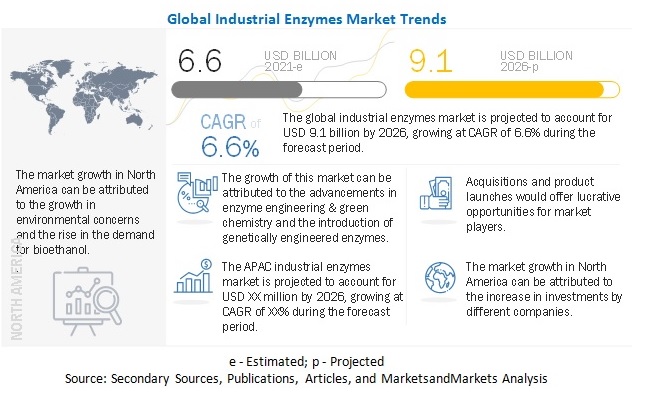
The global industrial enzymes market is estimated to be valued at USD 6.6 billion in 2021. It is projected to reach USD 9.1 billion by 2026, recording a CAGR of 6.7% during the forecast period. New technical applications of enzymes are being developed to enhance the production processes. Numerous companies in the textile industry incorporate enzymes as an alternative to chemicals to produce mild reactions that lead to clean and chemical-free garments. Gene modification in the existing enzyme has resulted in significant developments to enable enzymes to be functional under altering temperatures and pH levels.
Download PDF brochure: https://www.marketsandmarkets.com/pdfdownloadNew.asp?id=237327836
Drivers and Restraints:
Switch toward renewable sources of energy lead to increasing consumption of bioethanol
The need for non-renewable sources, such as fossil fuels, has increased during the last few decades; hence, the search for sustainable and renewable alternative sources has gained growing interest. Enzymatic hydrolysis in bioethanol production presents a vital step, where sugars that are fermented are obtained in the final fermentation process. In countries with surplus agricultural capacity, ethanol produced from biomass can be used as a substitute, extender, or octane booster as an alternative for traditional motor fuels, such as gasoline, diesel, and kerosene. Bioethanol is prepared from agricultural waste containing corn stalks, leaves, bagasse of sugarcane, sugar beet, sorghum stalks, wheat, barley, rye, and by-products, such as whey from cheese making and potato processing waste streams.
Action of enzymes restricted to various external factors
The action of enzymes is largely influenced by the surrounding environmental conditions. A decrease in temperature causes the reaction rate to drop drastically, while thermal agitation denatures the food enzyme (deteriorates the food enzyme structure), thereby making it non-functional. Varying the pH outside the operational range of the food enzyme also reduces the enzyme activity and can ultimately lead to permanent denaturation. Food enzyme manufacturers strive to produce enzymes that can operate in a wide temperature and pH range; however, there is still a long way to go if enzyme use has to be universally implemented in all food & beverages manufacturing processes.
Request Sample Pages: https://www.marketsandmarkets.com/requestsampleNew.asp?id=237327836
Regional Analysis:
According to a study published by the United States Department of Agriculture (USDA) in 2018, the North American population spends almost 14% of their household expenditure on food. This resulted in food & beverage manufacturers incline toward increasing the shelf-life of various products, which would augment the demand for food enzymes in the North American region. According to the US Department of Health & Human Services, “From 1999–2000 through 2017–2018, the prevalence of obesity increased from 30.5% to 42.4%, and the prevalence of severe obesity increased from 4.7% to 9.2%.” The growing demand for clean-label and natural ingredients in the region is likely to drive its use in food applications in the US, Canada, and Mexico. Industrial enzymes used for baking, fats & oil processing, and dairy are likely to drive the growth of the market.
Key Market Players:
Key players in this market include DuPont (US), Associated British Foods plc (UK), DSM (Netherlands), Novozymes (US), CHr. Hansen Holdings A/S (Denmark), and Kerry Group (Ireland).